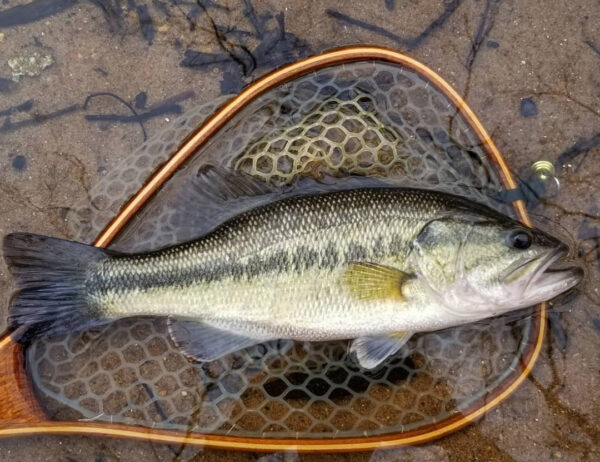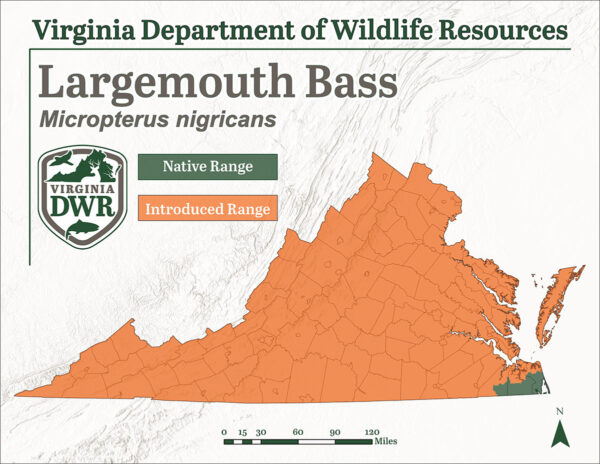Region II Fisheries Biologist Hunter Hatcher displays two Largemouth Bass collected during a fish community survey.
Region IV Fisheries Biologists Mike Isel and Robbie Willis showing off a couple of nice Largemouth Bass collected during a sampling event.
A Largemouth Bass being processed during a fish community survey. ©Photo by Hunter Hatcher
Fact File
Scientific Name: Micropterus nigricans
Classification: Fish, Order Perciformes, Family Centrarchidae
Size: Largemouth Bass can reach 16 pounds in Virginia
Life Span: Largemouth Bass can live to about 15 years in Virginia
Identifying Characteristics

- Jawbone extends beyond the eyeball when mouth is fully closed
- Dark olive on the back, often transitioning to greener sides, and a cream underbelly
- When open, the mouth of the Largemouth Bass is wider than its head
- A dark lateral stripe or blotches along the side
- Moderately forked caudal fin
- Spines on the first dorsal fin
Distribution:
Largemouth Bass are one of the most popular sportfish in the United States, and are found throughout all of Virginia. They are native to a small portion of the Albermarle basin in southeast Virginia.

Habitat

Largemouth Bass prefer slow moving, calm and clear waters with soft substrates. Largemouth Bass will often utilize underwater structure such as logs, rootwads, and submerged aquatic vegetation for protective cover and opportunistic feeding opportunities. Largemouth Bass take advantage of different water depths at different times of the year, which influences their metabolic needs and feeding strategies.
Diet
Largemouth Bass are opportunistic ambush predators and will consume most organisms they’re able to catch. Regular prey items include other fish, amphibians, crayfish, and insects. While Largemouth Bass will feed throughout the day, they are especially voracious during low light hours.

A Largemouth Bass captured while digesting its most recent meal.
Reproduction
Largemouth Bass breed in the spring. In Virginia, the process typically occurs between March and May. Males prepare the nests, often referred to as beds, in substrates made of sand or clay. Males will attempt to pair with a female, and if receptive, she will deposit eggs for the male to fertilize. Males initially guard the nest, as well as the newly hatched young, but will also cannibalize young in some circumstances. It is common to see males and females paired together near the shoreline during the spawning process.

Tidal Rivers Project Leader Margi Whitmore with two sizeable Largemouth Bass.
Additional Information
Last updated: July 18, 2024
The Virginia Department of Wildlife Resources Species Profile Database serves as a repository of information for Virginia’s fish and wildlife species. The database is managed and curated by the Wildlife Information and Environmental Services (WIES) program. Species profile data, distribution information, and photography is generated by the Virginia Department of Wildlife Resources, State and Federal agencies, Collection Permittees, and other trusted partners. This product is not suitable for legal, engineering, or surveying use. The Virginia Department of Wildlife Resources does not accept responsibility for any missing data, inaccuracies, or other errors which may exist. In accordance with the terms of service for this product, you agree to this disclaimer.

